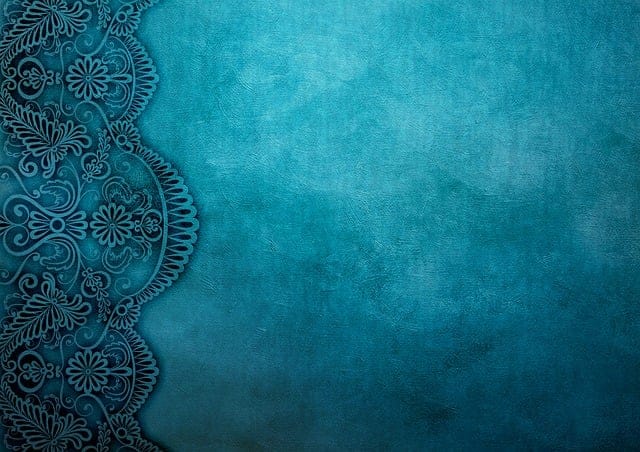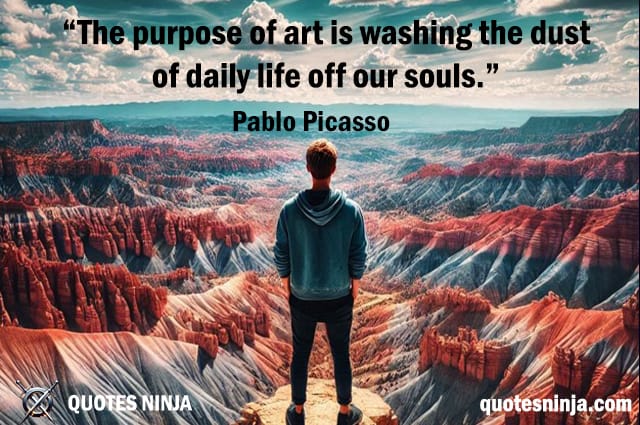
Art Quote: The quote “The purpose of art is washing the dust of daily life off our souls” by Pablo Picasso offers a profound reflection on the transformative and rejuvenating power of art.
Deeper Meaning of Art Quote by Pablo Picasso:
“The purpose of art is washing the dust of daily life off our souls“
- Art as a form of escape and renewal:
- Daily life often comes with routine, stress, and the weight of responsibilities. These can metaphorically “dust” the soul, leaving us feeling mentally and emotionally drained.
- Art, in this context, acts as a means of escape or relief, helping individuals break free from the monotony or pressures of everyday life. It provides a space for reflection, creativity, and inspiration, allowing people to reconnect with deeper, more profound aspects of themselves.
- Emotional and spiritual cleansing:
- Just as physical dust can accumulate and make things look dull or dirty, emotional or spiritual “dust” can accumulate over time due to stress, hardship, or routine.
- Art serves as a cleansing agent for the soul, helping people process their emotions, reflect on their experiences, or experience catharsis (emotional release).
- Whether through music, painting, sculpture, or other forms, art allows individuals to confront their inner world, work through their struggles, and emerge feeling renewed.
- Reconnecting with the beauty of life:
- In a world that often focuses on the practical, functional, and everyday aspects of life, art helps people reconnect with beauty, wonder, and meaning. This act of rediscovery can refresh the soul and provide a sense of purpose or transcendence.
- Art invites individuals to see the world through new lenses, offering a sense of joy, awe, and emotional depth that may be overlooked in the routine of life.
- Art as a mirror for the human condition:
- Art can reveal and express the complexity of the human experience, helping us make sense of our lives, struggles, and joys.
- By engaging with art, whether as a creator or an observer, we can gain insights into our own emotional and spiritual landscapes, enabling personal growth and healing.
- Healing through creativity:
- Art encourages creative expression, which can be therapeutic. It provides a safe space for individuals to channel their thoughts, emotions, and experiences in constructive ways, leading to personal transformation.
In essence, Picasso’s quote highlights that art has a profound power to uplift, heal, and inspire us. It reminds us that in the midst of life’s daily grind, art offers a vital space for renewal—where we can find clarity, joy, and meaning. It “washes” away the emotional weight of the ordinary, helping us reconnect with the deeper and more beautiful aspects of life.
Here’s a story inspired by Art Quote “The purpose of art is washing the dust of daily life off our souls.“
“The Artist’s Brush”
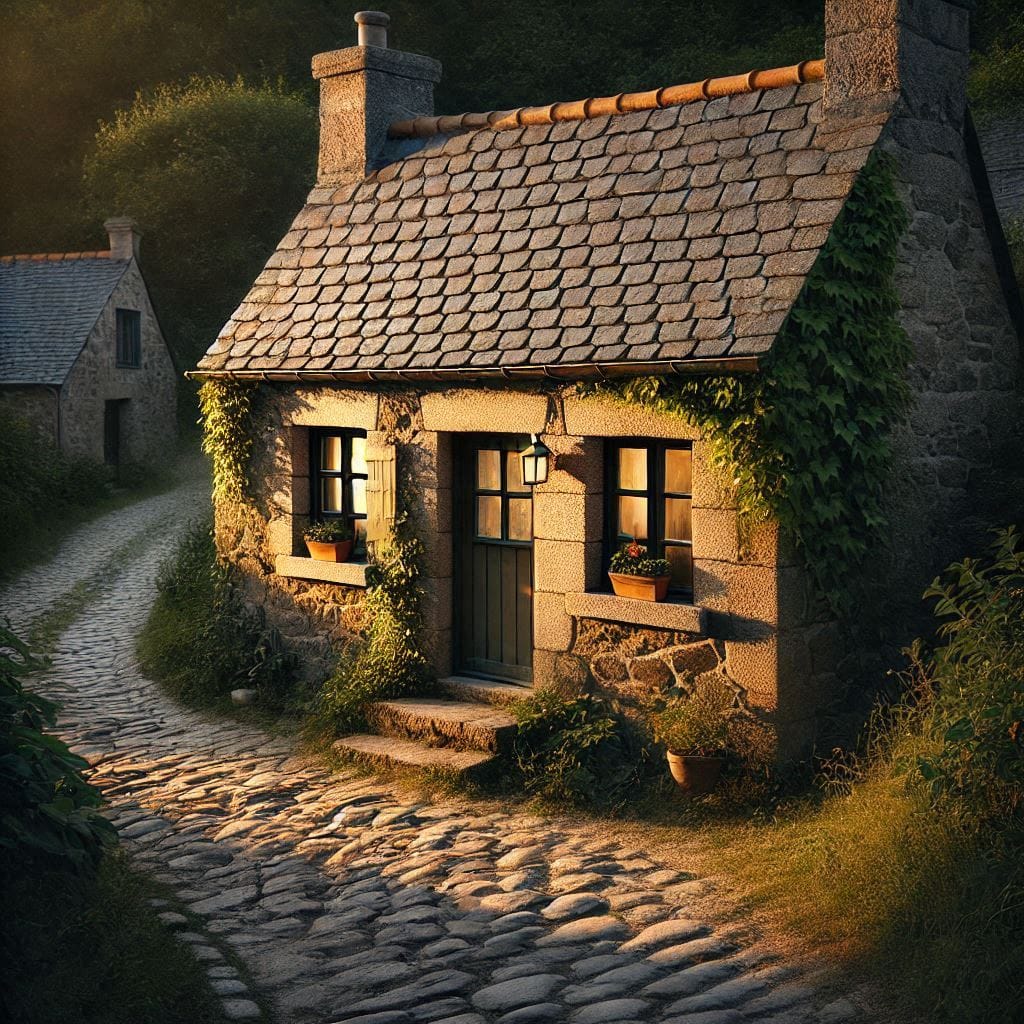
In a small, sleepy town nestled between rolling hills, lived an old painter named Eli. His house was perched on the edge of the village, a modest cottage with ivy creeping up the sides and windows that always seemed slightly fogged, as if looking inward, not out. Eli had lived in the town for as long as anyone could remember. He was known for his quiet nature, his untamed white beard, and the countless canvases stacked up in his cottage—some finished, some abandoned halfway through.
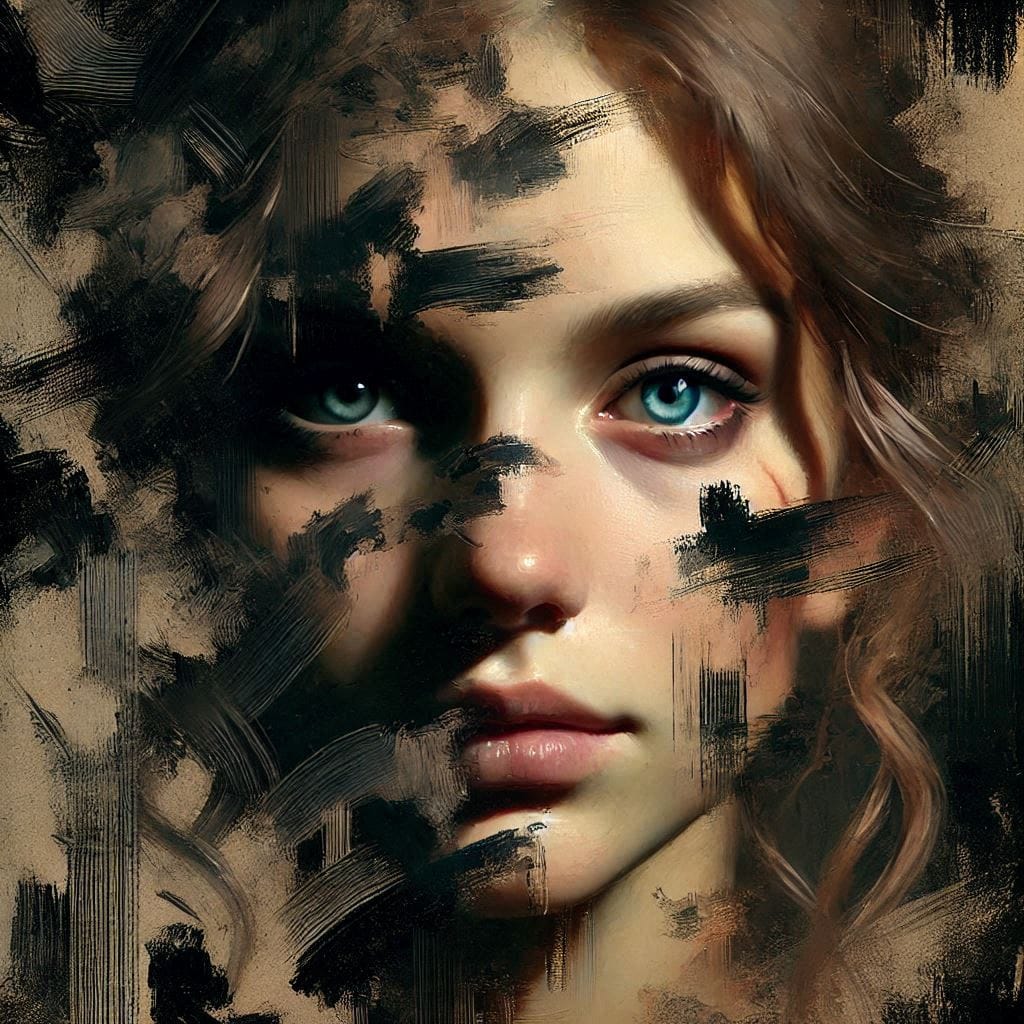
The townspeople often passed by his house, but they rarely saw him. He was a man who seemed to belong more to the past than the present, a relic of an earlier time when people spoke less and listened more. He was an enigma, like the half-finished portraits that lined his walls, each one capturing some emotion just beyond the reach of words.
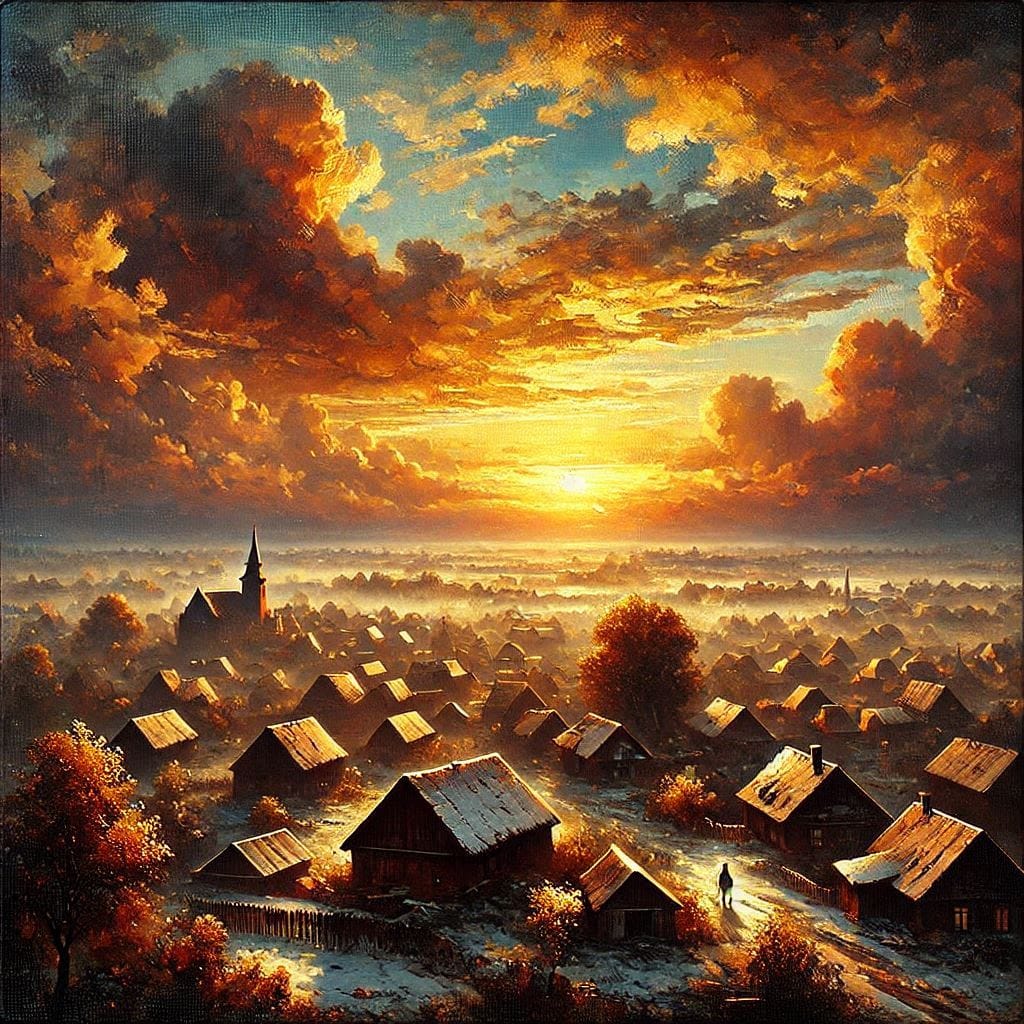
The town was a place where days seemed to blend into each other—tangled in the rhythm of work, school, and simple routines. The people went about their lives in a sort of haze, performing their daily duties, yet something always seemed missing. They were disconnected from the deeper rhythms of life, as if they were walking through a fog, unaware that there was something beyond the mist.
One evening, a young woman named Clara, who had recently moved to the village, decided to visit Eli’s house. She had heard the stories—the strange things people said about his paintings, the whispers of how his work made people feel something they hadn’t felt in years, if ever. Curious and longing for something beyond the ordinary, she knocked on his door one cool autumn afternoon.
Eli answered with a gentle smile, as though he’d been expecting her. His voice was soft but inviting. “Come in, child,” he said, stepping aside.
Clara entered the dimly lit room, her eyes immediately drawn to the canvases that covered every inch of wall space. Some were abstract, swirling with colors that didn’t seem to belong together, while others were portraits—faces frozen in time, expressions both joyful and sorrowful.
“What are they?” Clara asked, her voice full of wonder.
“They are stories,” Eli replied simply. “Stories of the soul.”
Clara felt a shiver pass over her. The paintings seemed alive, as if they were telling secrets only the heart could understand. She picked up one of the half-finished portraits of a woman, her face partially obscured by dark strokes, as though the artist hadn’t quite decided whether to reveal her fully to the world.
“What’s this one?” Clara asked, holding the painting in her hands.
Eli’s eyes softened. “That’s Anna. She was the baker’s daughter. She came to me years ago, lost in grief after the death of her father. She couldn’t breathe, couldn’t sleep. The dust of life was choking her. It was then that she asked me to paint her.”
Clara frowned. “But… she’s not finished.”
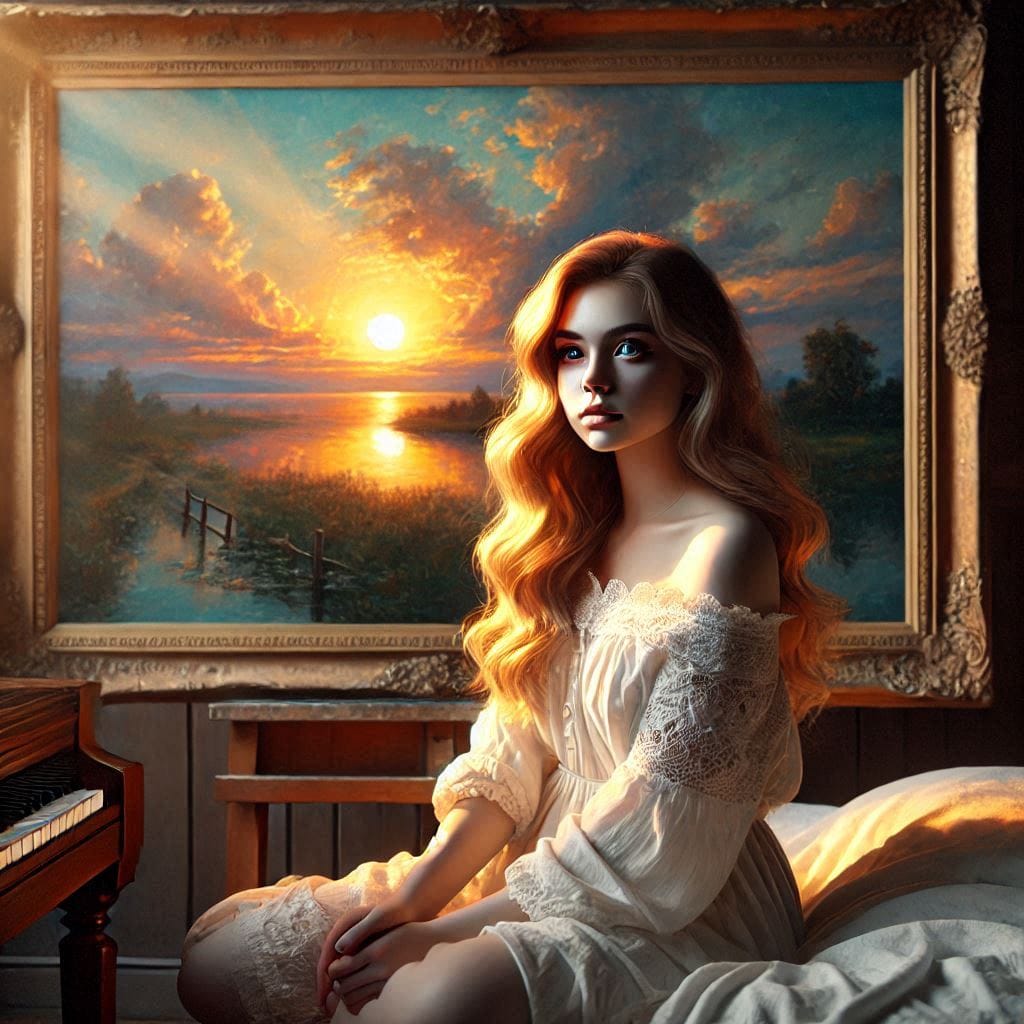
Eli nodded slowly. “No. She couldn’t be, not at that time. Sometimes, it’s the absence, the spaces between the strokes, that hold the most meaning.”
Clara thought about that for a moment. It was true, in a way. Sometimes the pauses in life—the moments between actions—held more truth than anything that could be said or done.
Eli guided Clara to a chair by the window, where a smaller canvas rested on an easel, freshly painted. It was a scene of the town—a landscape bathed in the golden glow of sunset, the hills beyond the village stretching into an endless sky.
“Do you see the dust in the painting?” he asked, his eyes twinkling.
Clara leaned in closer. At first, she didn’t understand. The painting was beautiful, peaceful even. But then, she noticed the faint smudge of gray across the horizon, just at the edge where the sun met the earth. It was almost imperceptible, like a shadow hanging on the edge of the canvas.
“What is it?” Clara asked, puzzled.
“That’s the dust of daily life,” Eli said, his voice softer now. “It’s the burden we carry, the things we don’t even realize we’re holding onto. The worries, the responsibilities, the routines that seem so heavy. They cloud our vision, and we forget what it means to be truly alive.”
Clara’s heart fluttered. She had been feeling that weight herself—she’d come to the village seeking something, though she hadn’t known what. The days had passed, filled with small tasks and conversations, yet a sense of emptiness lingered, a dull ache she couldn’t shake.
Eli gestured toward the painting again. “But in art, you see, you can wash the dust away. You can look at something and feel it open your soul. It’s not just about seeing the colors; it’s about feeling them, about letting the shapes and lines remind you that there is more than the daily grind.”
Clara stared at the painting of the sunset, now seeing it in a different light. The dust was still there, but it didn’t feel so heavy anymore. The painting, in its simplicity, had made her aware of the beauty around her—the light that broke through the dark clouds, the way the world seemed to breathe.
“Do you feel it now?” Eli asked, his voice barely a whisper.
Clara nodded slowly, her eyes welling up with something unspoken. She didn’t know if it was relief or awe, but in that moment, she realized something deep inside her had shifted. The dust had lifted, if only for a little while.
“I think I do,” she whispered back.
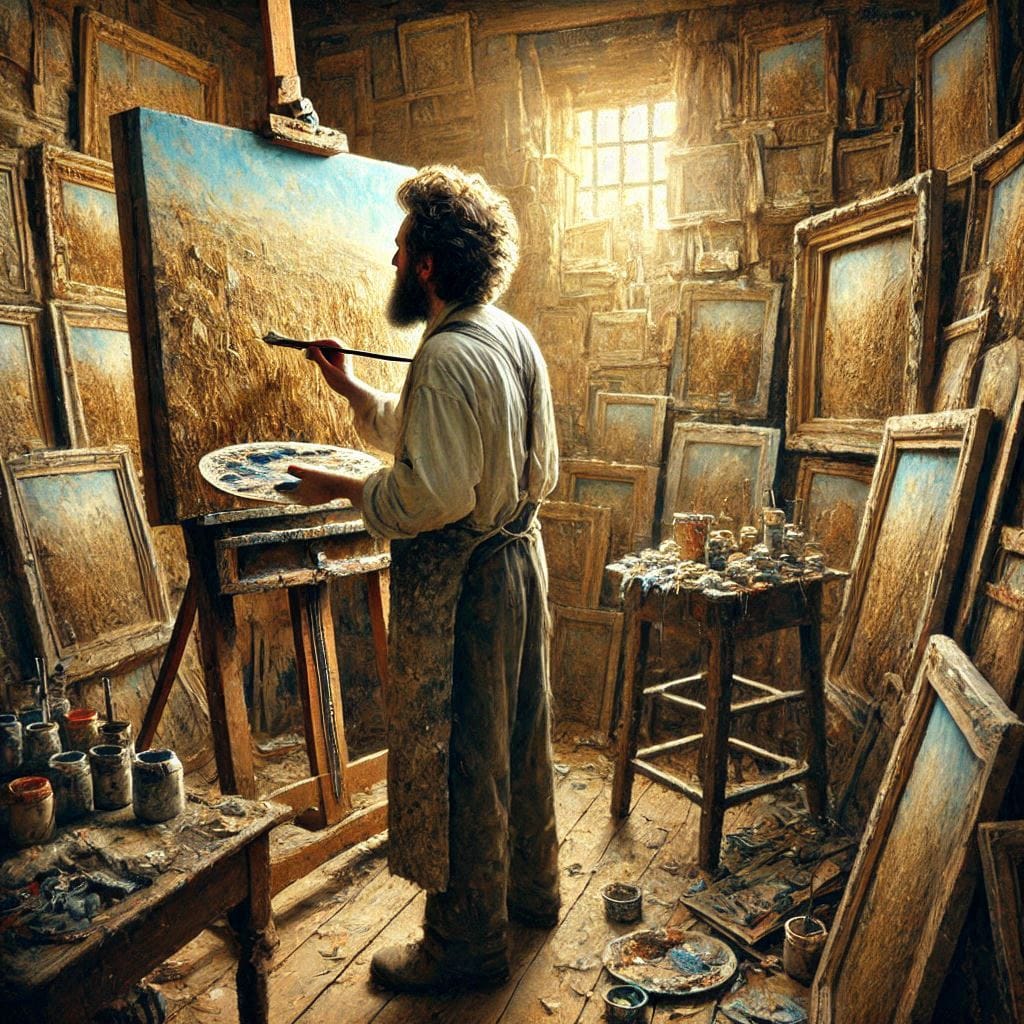
Eli smiled and turned to his easel, picking up his brush. He dipped it in paint, then paused. “Art,” he said, “is not just about what you see. It’s about what it makes you feel. It’s the dust that comes off your soul when you let it in.”
Clara left Eli’s cottage that evening with her heart lighter than it had been in a long time. The sun had set, but the sky was still rich with colors—vibrant, deep, and full of life. She understood, now, that art was more than just an expression of beauty. It was a reminder to reconnect with the deeper parts of ourselves, to wash away the layers that life so often piles on, and to let the soul breathe again.
Here is the end of Art story of quote “The purpose of art is washing the dust of daily life off our souls.“
To explore more on stories and dive into related ideas, be sure to check out the other posts where we cover all sort of stories related to quotes. Stay tuned for more…..
To explore more on quote topics, be sure to check out the other topics where we cover all categories of quotes. Stay tuned for more…..

